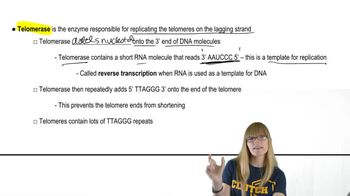Here are the essential concepts you must grasp in order to answer the question correctly.
Telomeres
Telomeres are repetitive nucleotide sequences located at the ends of linear chromosomes. They protect the chromosome from deterioration or fusion with neighboring chromosomes, which is crucial for maintaining genomic stability. Each time a cell divides, telomeres shorten, and when they become too short, the cell can no longer divide, leading to cellular aging.
Recommended video:
Telomerase
Telomerase is an enzyme that adds nucleotide sequences to the ends of telomeres, counteracting the shortening that occurs during DNA replication. It is composed of a protein component and an RNA template that guides the addition of telomeric repeats. Telomerase is particularly active in stem cells and cancer cells, allowing them to maintain their telomere length and proliferate indefinitely.
Recommended video:
Mechanism of Telomerase Action
The mechanism of telomerase action involves the enzyme binding to the 3' end of a telomere and extending it by adding DNA repeats using its RNA template. This process occurs in a series of steps: the enzyme first aligns with the existing telomere, then synthesizes new DNA, and finally translocates to repeat the process. This action effectively replenishes the telomere length, ensuring chromosome integrity during cell division.
Recommended video:




